Cartridge Discussion: The .38 Long Colt
Some small flicker of interest in the .38 Long Colt vs. the Moro tribesmen was generated on another current thread running on "Defensive Ammunition & Ballistics" so we'll start this old piece written some years back for the few who might have ever wondered about other .38 cartridges from days of yore. Or, perhaps someone has an old .38 Long Colt chambered arm lurking in dark recesses of their firearms accumulation and would like to fire a few rounds through it.__________________________________________________ ________________
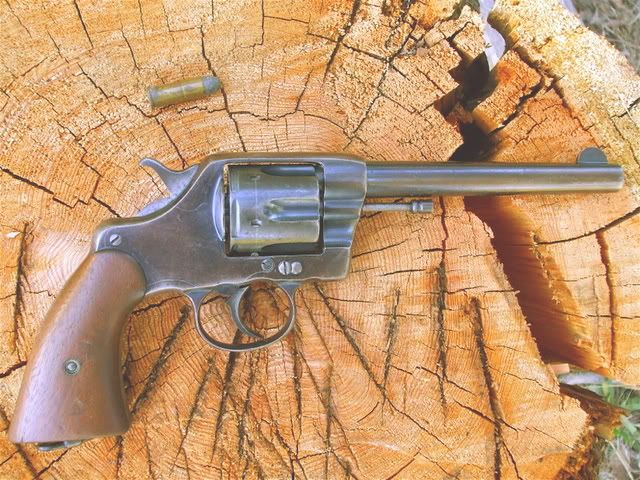
This old wheezer represents an important stop along the path of the development of .38 caliber cartridges and was in wide use during a very colorful part of our nations history. Though obsolete now it once was considered suitable for use in side arms equipping the military services serving our great republic. We recently reviewed the .30-40 and the Krag rifle which was used to fight our nations battles around the turn of the 20th century so lets take a look at the military issue revolver cartridge of that important era.
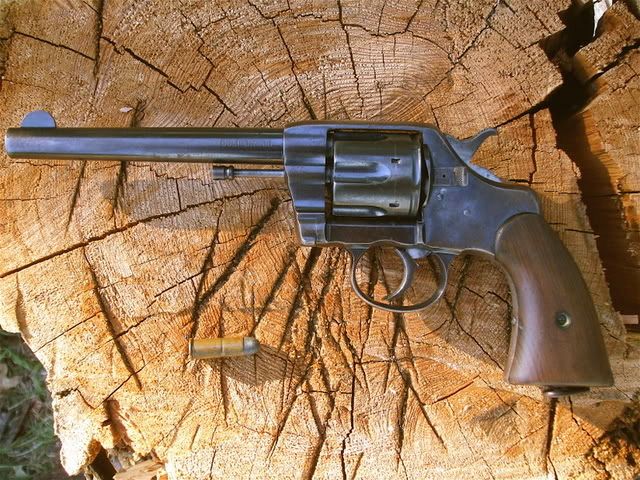
The .38 Long Colt was a very early center fire revolver cartridge, first appearing in 1875 in the Colt New House and New Line revolver models. It gained greater popularity when the Colt Model 1877 double action revolver was introduced. Nick-named the Lightning in .38 Long Colt, this model revolver in .41 Long Colt was popularly referred to as the Thunderer. The .38 Long Colt was commonly available throughout the last three decades of the 19th century, playing a part in the settlement of the West. It also saw wide use in law enforcement and for personal self-defense. Colt, Merwin Hulbert and other makers chambered revolvers to take the .38 Long Colt cartridge. The common factory load consisted of a 150 grain heeled lead bullet, propelled by a charge of 18 grains of black powder. Muzzle velocity was 770 feet-per-second. Muzzle energy would have been 195 ft. lbs. The heeled bullet had a diameter of .357". The standard bore diameter for the .38 Colt was .362". The bullet expands to fit the bore. The heeled bullet design is still employed to this day in .22 rim fire ammunition. Some one else will have to explain just why Colt chose to design several of its proprietary revolver cartridges to use the heeled bullet. The outside lubrication was messy and they had a reputation for inaccuracy. Ive seen various explanations offered including: suitability for cartridge-conversion percussion revolvers, an effort to improve accuracy, and to compensate for black powder fouling. The Colt cartridges faded away while the conventionally designed Smith & Wesson cartridges of similar caliber remained popular. In my VERY limited use of the .32 Long Colt, .38 Long Colt, and .41 Long Colt ammunition the heeled bullet has given respectable accuracy.
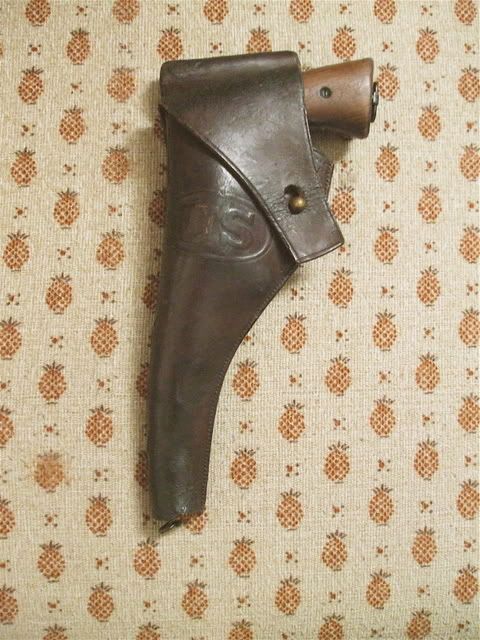
The high water mark for the .38 Colt was reached in 1889 when the U.S. Navy, and the Army soon after, awarded Colt contracts for its latest double action revolver so chambered, in order to arm American servicemen. The Colt New Arm and New Navy (two separate model names but the same revolver) featured a cylinder that swung out to load/unload. This was the first side-swing revolver, a design that is still commonly used today. A modern double action revolver featuring simultaneous ejection of spent cartridges was deemed advantageous over the .45 Colt Model 1873 Single Action Army revolver which had equipped the army for the previous 16 years. Reloading the single action Colt revolver was slow and cumbersome, especially for the mounted cavalryman. The function of the new Army revolver appears to be well though out except for its .38 Long Colt chambering which must not have received much thought at all. The .45 had it all over the new .38 where it counted most; out where the shootee" is.
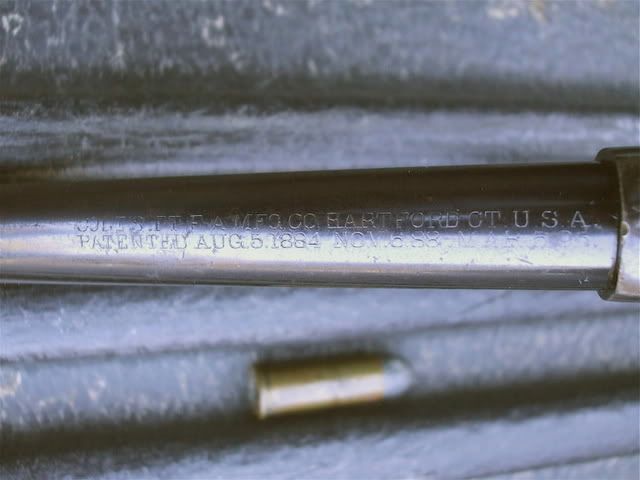
The Colt double action Army revolvers and their .38 cartridge were called to action in 1898 for the Spanish American War. Teddy Roosevelt obtained one that had been retrieved from the Battleship Maine, sunk in Havana harbor. He galloped up San Juan (actually Kettle) Hill towards a blockhouse and its Spanish defenders with this Colt in hand, dispatching an enemy soldier with the revolver. The United States emerged from that war with new possessions in the Caribbean and the Philippines. The .38 revolvers apparently satisfied their users in this conflict as little was mentioned about them. I suspect they werent much employed and the few enemy combatants on the receiving end of the uninspiring .38 Long Colt had the good grace to behave properly after having been shot.
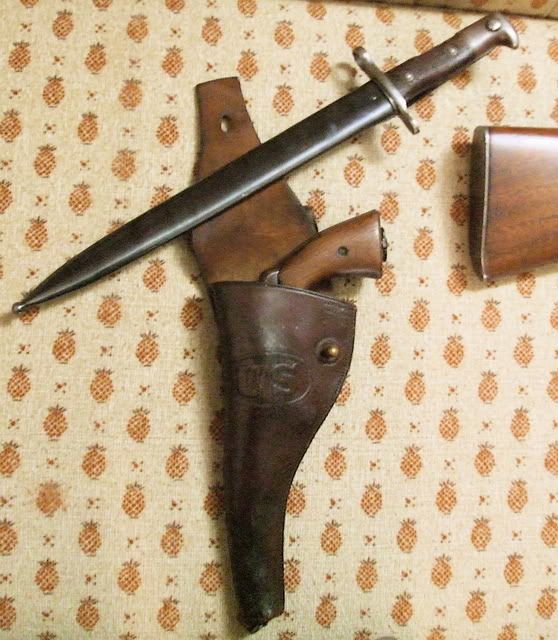
Not so with the Juramentados encountered in the Philippines when U. S. Troops took over occupation and administration of that archipelago after cessation of hostilities with Spain. These fanatical Muslim tribesmen would drug themselves up, bind their bodies tightly to retard blood loss and protect them from bullets, and run amok, attempting to take out as many infidels as possible before their own inevitable deaths. They despised any foreign rule. They had been the scourge of the Spanish for years and now their wicked kris and barongs dripped with the blood of many U. S. soldiers who encountered them while on occupation duty. These encounters demoralized troops making it dangerous to leave garrison except in groups yet groups were no guarantee of safety. Groups were fine with the Juramentados, the more the merrier! They believed that Allah would richly reward the man who accepted greater odds and strove to kill as many unbelievers as he could before his own death. The .38 Long Colt was found to be sadly lacking in power when employed against these suicidal and murderous attackers. In addition to the basic inadequacy of the cartridge, it has been since suggested that some suppliers provided the Army with substandard lots of .38 ammunition, which produced much lower velocity than specified in contract. The .45 Colt Model 1873 single action revolvers that were still in Army stores were trotted out of retirement, refurbished and sent to the occupation zone as rapidly as possible. Reports from soldiers in the field indicated that these revolvers of heavier caliber were greatly appreciated. The Army obtained supplies of Colts New Service revolver in .45 Colt, calling it the Model 1909; to supplement existing supplies of .45s in the Philippines. Small supplies of the primitive Model 1878 double-action revolver that the Colt factory had on hand already chambered for .45 Colt, were even purchased to provide needed big bore revolvers. The government embarked on the search for an effective handgun to replace the wretched .38s then in service, the result of which gave the world the brilliant Colt Model 1911 chambered for the excellent .45 ACP. But thats a whole different story.
The 20th century dawned with a new .38 cartridge to compete with the .38 Long Colt. This was Smith & Wessons .38 Special. Introduced in the closing months of 1899, the .38 Special was an effort to increase the power of a .38 caliber cartridge and win contracts to provide Americas military with Smith & Wessons newly designed K-Frame double action swing out revolver. The government purchased a few thousand of the Smith & Wesson revolvers but the big order never came. They just werent required as the Army had gone off the .38 caliber as a military weapon, even if this new round could provide more umph.
Though the .38 Long Colt made the transition to smokeless powder, as the first decade of the 20th century closed the .38 Special had completely supplanted it as the popularly provided chambering for mid-sized .38 caliber revolvers. Colt even appropriated the Smith & Wesson designed .38 Special, changing the bullet shape and calling it the .38 Colt Special. The era of the semi-automatic pistol was in its infancy and Colt was also marketing a new self-loading pistol chambered for its proprietary .38 ACP cartridge, a round similar in ballistics to the 9mm. When these developments hit the market the .38 Long Colt hit the skids.
Handloading and Shooting .38 Long Colt
I recall purchasing .38 Long Colt ammunition factory ammunition as provided by Remington and Winchester 30 years ago when I first acquired a Colt Model 1901 revolver. Im unaware of the year the old .38 Long Colt was finally discontinued but it left the catalogs several years back. Of late its been revived and offered by several makers thanks to the Cowboy Action shooting game. Im tickled to see the old round brought back for a new generation of interested shooters to use for a fun activity. Besides, now I can supply myself with genuine .38 Long Colt cartridge cases for my old Colt revolver.
The early Colt left-wheeler(so-called because the cylinder rotates counter clockwise like a Smith & Wesson revolver rather than clockwise like a modern Colt revolver double action revolver) were manufactured with cylinders that featured bored through charge holes with no shoulder. This characteristic is important to know for person who shoots his early Colt revolver. Any and all commonly encountered .38 cartridge cases along with the .357 Magnum case will drop right into the chambers of these revolvers. Now all factory loaded .357 magnum rounds will be too long for the cylinder to close but a .357 Magnum handload with a deep-seated bullet could fit and fire. Most factory .38 Special ammunition will chamber and the cylinder will close. Just because its a dimensional fit doesnt mean that old Colt revolver is designed to contain it. If a person wants to grenade one of these old revolvers, using improper ammunition is just the ticket. Ive seen one of these revolvers that had burst and also photographs of more failures. Its an ugly sight, especially when one considers where all the hunks of metal could end up.
That said, the handloader who knows what hes about and is detailed oriented can make up a batch of suitable loads to use in a .38 Long Colt revolver by utilizing published .38 Long Colt handloading data in unaltered .38 Special cases. One would have to take care to use the correctly prepared ammunition in the .38 Special cases in his .38 Long Colt revolver and not stray into his supply of normal .38 Special fodder. Uniquely marking each case or better yet, trimming to correct .38 Long Colt length could aid in identification. Some specialty ammunition companies have begun limited production of .38 Long Colt Ammunition and can also provide unprimed cases. This is in response to the Cowboy Action Shooting game that has attained great popularity over the past 15 years. Since the cartridge case is again available itd be best to invest in a few boxes of proper .38 Long Colt brass rather than using the expedient .38 Special case.
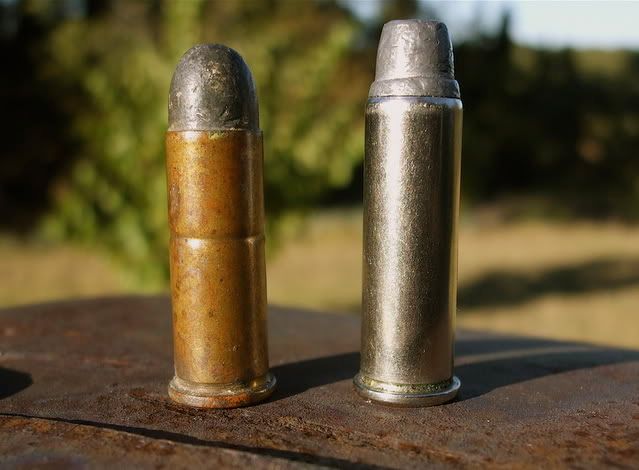
The .38 Long Colt shown with the longer and more powerful .38 Special
Handloading Results
Using .38 Long Colt cases
148 grain hollow based wadcutter, Bullseye: MV 752 fps ME 185 ft./lbs. ES 62
158* grain SWC, Unique: MV 753 fps ME 189 ft./lbs. ES 57
Using .38 Special cases
158* grain SWC, Unique: MV 777 fps ME 211 ft./lbs. ES 72
Western 150 grain Luballoy Factory Load: MV 743 fps ME 183 ft./lbs. ES 64
Winchester 150 grain round nose Factory: MV 638 fps ME 135 ft./lbs. ES 53
Frankfort Arsenal 4-11 Factory Load: MV 671 fps ME 150 ft/lbs. (fired single example)
Velocity data taken with a Colt Model 1901 with 6-inch barrel
Oehler Model 12 Chronograph used
*Don't expect anything resembling accuracy when using undersized .358 diameter bullets in the .38 Long Colt chambered Colt revolvers made before the introduction of the Model 1903.
Some say the old .38 Long Colt revolvers should be retired and not fired at all but I dont intend to put mine out to pasture completely. Im a history buff and enjoy hands-on experience with historical firearms. I use carefully prepared ammunition put up in proper .38 Long Colt cases. Parts breakage is a real possibility and the only Colt revolver that has ever failed me is the Model 1901, which once broke a trigger return spring. Colonel Snodgrass of Fort Worth, Texas made a perfect replacement spring for me. The lock work is delicate and one would be wise to **** the hammer smoothly when using the revolver in single action mode rather than snapping it back to full ****. Stay away from rapid-fire double action shooting as well, instead pulling the trigger through smoothly so as to avoid battering the locking bolt and cylinder notches. Ive never used the Colt Model 1877 Lightning revolver but they have a reputation for being even more fragile so take care with them as well.
Range time with one of the old Colt Army .38s is good fun. The revolver with its six-inch barrel feels most elegant when sighted using the one-handed hold characteristic of the time of its issue. My revolver hits to point of aim at 12-15 yards with the 148 grain HBWC handloads or factory loads if I make careful use of the minuscule sights. Recoil is mild. The single action trigger of my Mode 1901 is quite heavy with a bit of creep, which makes it a chore to shoot really tight groups. The double action function is not a good experience. Heavy and uneven best describes it and my revolver is tight and properly timed. Did I say it has a bad double action? One will probably fire a few rounds double action for effect and the novel experience but a few will satisfy curiosity.
Good bullets are a problem for the .38 Long Colt revolver with its odd .362 bore. Normal .358 lead bullets intended for the .38 Special or .357 Magnum will give 12 inch groups at 10 yards with keyholes abounding. The bullet caster can acquire molds of proper dimensions. My favorite solution is to use 148 grain hollow based wad cutters intended for the .38 Special. My old Colt Model 1901 shoots them a treat with mild charges of Bulls-Eye or Unique. For me the HBWC represents a problem solved with its almost identical weight to the original bullet and its ability to fill the bore. The Model 1903 revision of the Colt military revolver and contemporary Colt commercial revolvers manufactured beginning about 1903 are made with tighter bores of approximately .358 diameter and so handle the common .358 bullets with satisfaction.
If push came to shove and a .38 Long Colt had to be pressed into service as a self-defense handgun it certainly wouldnt be the worst thing to use. While no powerhouse itd be at least as effective as a .380 ACP. This assumes ammunition that equals the ballistics quoted above in the first paragraph. There are some modern handguns on the market that are widely popular for concealed carry and self-defense that are less powerful than the .38 Long Colt.
The .38 Long Colt will suffice for field use on small game. Years ago I was asked to collect a fine specimen of an armadillo by an old friend of mine so he could have it stuffed as a Christmas gift for his son. I decided to use my Colt 1901 for the job. I strolled through the oak woods near our slough at at our old family lake property listening for the sound of an armadillo shuffling through the leaves in search of bugs. As they are plentiful I passed on several before finding a large one. I plugged this armadillo through the front of the bands of the shell rather than through the hard portion of the shell in order to make any repair work easier for the taxidermist. I saw a red spot appear right where I aimed. I was very surprised when this armadillo scrambled away to his hole. I had to seek out another. This time the same shot netted me my quarry. I was using some Winchester-Western factory loads in the yellow box.
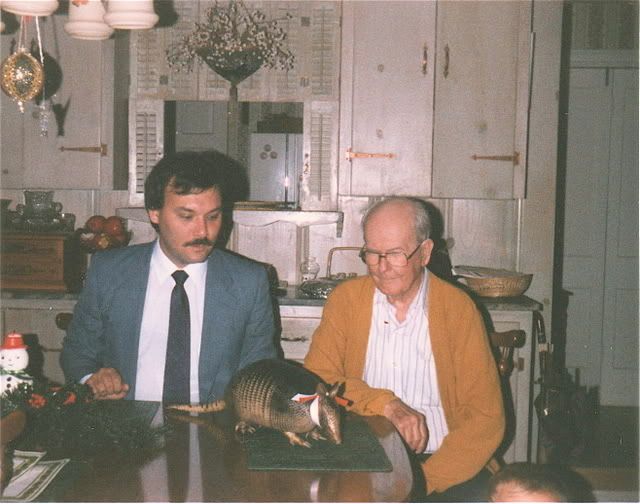
The .38 Long Colt has no reason for being at this point in time. Or perhaps it does. Modern shooters are employing it for a purpose not originally considered primary by its 19th century makers and users who fought with it, used it for serious protection from evildoers, or used it for evil on occasion. It now has the honor of being used just for fun.



